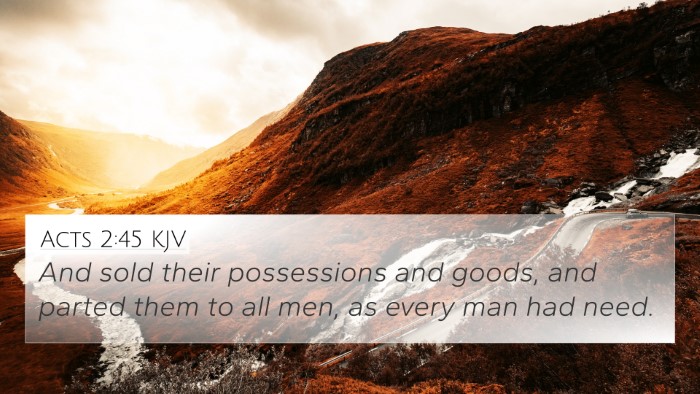Understanding Acts 4:34
Acts 4:34 states, "Neither was there any among them that lacked: for as many as were possessors of lands or houses sold them, and brought the prices of the things that were sold." This verse highlights the selflessness and communal spirit of the early Christian community in Jerusalem.
Summary of Insights
The essence of this verse reflects the radical generosity that characterized the early Church. The believers sold their possessions to contribute to the welfare of the collective community. According to Matthew Henry, this act symbolizes a profound commitment to unity and mutual support, demonstrating the new life in Christ.
Albert Barnes notes that this verse portrays how the believers prioritized the community over personal wealth, showing that they were guided by love and care for their fellow brethren. This emphasizes the practical manifestation of love in action, reinforcing the teaching of Jesus about caring for others.
Adam Clarke elaborates on the significance of economic sharing within the church, explaining that this behavior reinforced the idea that all believers were part of one body, where each member has a role. Consequently, their sharing was not merely an act of charity, but a reflection of their identity and unity in Christ.
Cross-References
This verse connects with several other scriptures that highlight themes of community, sharing, and generosity:
- Acts 2:44-45 - Describes the believers selling their possessions and distributing to those in need.
- 2 Corinthians 8:13-15 - Paul discusses the idea of equality in giving, echoing the principles seen in Acts 4.
- Philippians 2:4 - Encourages believers to look out for the interests of others, resonating with the communal spirit depicted in Acts 4.
- Romans 12:10 - Urges believers to love one another with brotherly affection, aligning with the practices of the early church.
- 1 John 3:17-18 - Defines love as actively caring for the needs of others, much like the early Christians in Acts.
- Luke 12:33 - Jesus instructs to sell possessions and give to the poor; a principle lived out by the early believers.
- Galatians 6:2 - Calls believers to bear one another’s burdens, a theme embodied in the community of Acts.
Thematic Bible Verse Connections
Throughout the New Testament, the theme of community and shared resources emerges consistently. Acts 4:34 serves as a vivid example of how early Christians interpreted Jesus' teachings on love and generosity.
The act of selling possessions symbolizes a profound understanding of stewardship; as articulated in 1 Timothy 6:17-19, where Paul instructs the rich to be generous, thus providing a direct link to the principles upheld in Acts.
Practical Implications for Today’s Believers
This verse invites modern believers to reflect on their attitudes toward possessions and generosity. The radical commitment to community welfare may inspire contemporary church practices aimed at supporting those in need.
It prompts questions about how personal resources can be utilized for the greater good of the Christian community and emphasizes the importance of being open-handed and willing to share.
Tools for Bible Cross-Referencing
Understanding Acts 4:34 requires utilizing various Bible cross-reference tools which can help believers make connections with other scriptures that discuss similar themes. Some effective tools include:
- Bible concordances that provide indexes of scripture based on themes and keywords.
- Online cross-reference guide applications that allow users to find related verses easily.
- Comprehensive Bible cross-reference materials highlighting thematic connections across both the Old and New Testaments.
Finding Cross-References
To effectively find cross-references in the Bible, one can begin by identifying keywords and themes present in Acts 4:34. By following these terms through a cross-reference Bible study, believers can discover a network of related verses that reinforce the core message of communal support and generosity.
For example, when studying the communal aspects of Acts 4, consider looking at how the surrounding verses like Acts 2:42-47 mention the practices of prayer, fellowship, and breaking of bread, which showcase an all-encompassing community experience.
Conclusion
Acts 4:34 serves as more than just a historical fact; it’s a call to embody the selfless love illustrated by the early church. Through various cross-references, we see that this theme of self-giving is rooted deeply in the teachings of Jesus. The church today can learn much from this model of community care and embed it in their own practices.
By engaging with scripture deeply and exploring the interconnectedness of biblical texts, believers can gain richer insights and a more robust understanding of their faith.














